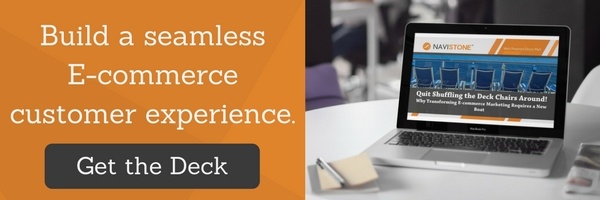For many E-commerce marketers, modern day marketing is both a blessing and a curse. There’s never been more ways to reach consumers and drive revenues, but it’s difficult to align all of the various means of marketing communication. However, the cluttered digital landscape means that it’s harder to make an impression with consumers online. That’s where tactics like direct mail retargeting can be tremendously beneficial as you look for new ways to engage your consumers with thoughtful marketing.
Consumers Are Everywhere
For all of the emphasis placed on digital marketing in E-commerce, it’s important to remember that consumers don’t exist solely on the Internet. They’re everywhere — online and offline, in stores and reading catalogs. The average person receives more than 2900 marketing messages a day. What’s more, people don’t choose only one outlet to engage with your brand. The same person might look at your product in a store, buy it through your website, review it on Amazon and post a video of your item on YouTube. Multiply this by the size of your entire audience, and you can see how it can be hard to keep track of your consumer base.
Since your audience uses so many different mediums, it’s your job to not only optimize your message to all of these different platforms, but to deliver a consistent message every time. The old silo mentality doesn’t work anymore. Your E-commerce unit can’t work separately from your catalog department, and your in-store setups have to match your online displays. It’s not about getting clicks or generating massive visibility. Instead, it’s about appearing as a unified front at every customer touchpoint, because it’s only through consistent delivery of customer-focused experiences that you can ever expect to receive long-term loyalty from your audience.
Using Direct Mail to Improve Retargeting
One of the major challenges faced by all businesses is finding ways to stand out in a digital marketing world that has become very saturated. Ad blockers are negating the already minuscule effectiveness of digital display ads, and consumers are well-versed in tuning out the ads that they’re able to see. This makes it very difficult for a marketer to engage in retargeting, which has been a largely digital-based strategy.
The good news is that retargeting doesn’t have to be an online-only proposition. Direct mail retargeting incorporates the same methodology and goals of online retargeting, but it uses a medium that’s much more likely to yield a positive response.
On the surface, this might seem counter-intuitive. Why use a more expensive medium to replace a cheaper one? The reality is, many digital retargeting efforts are typically ignored or unnoticed, due in part to the massive amount of online advertising that’s already out there. Going the direct mail route means getting an express trip to the front of the line. With so many companies thinking digital, there’s less competition in the physical inboxes of your customers. And since fewer companies are investing in direct mail, you have a great chance at making an impact — especially since the very nature of retargeting means you’re pitching something in which the consumer has already shown interest.
The best part of all, though, is the response rate. According to the Data and Marketing Association, the direct mail household response rate is 5.1%. This is the highest response rate the DMA has ever reported. Direct mail continues to be an untapped marketing medium that combines the data-driven online approach with high-response offline results — that’s the real power of direct mail retargeting.
Individualized Direct Mail Spurs Action
We all know that a major advantage of online marketing is its ability to turn data into individualized marketing that appeals to each customer in a unique way. But much like the nature of retargeting itself, this data conversion isn’t restricted to online marketing. Modern technology allows direct mail to utilize this same idea of personalization, creating a fully individualized marketing medium with reach and effectiveness that’s not typically seen in digital only E-commerce marketing.
A common form of individualized direct mail marketing occurs when local businesses send “Welcome to the Neighborhood!” advertisements to people who are moving into the area. For E-commerce, “Welcome to the Neighborhood!” postcards may seem like a wasted marketing effort, especially if you’re viewing your E-commerce site as a separate entity from a physical store location. But they don’t have to be. To that person, the postcard is a friendly welcome from a business that wants to get to know them better. To the business, it’s a great olive branch to send to consumers who have yet to establish iron-clad ties to specific companies, both online and offline, in their new community. It’s an arrangement that benefits everyone, especially if the “Welcome” postcard provides the option of online ordering with in-store pickup, which is convenient and easy for shoppers.
The Data and Marketing Association states that targeting customers on a 1:1 level increases response rates up to 50% or more. This mutually beneficial arrangement between consumers and a business’s online and in store experience is also seen in direct mail retargeting. While the company benefits from the higher direct mail response rate, the consumer gets an individualized marketing message in the privacy of their own home. No longer do they have to look at the same items on banner ads on the websites they visit for weeks on end. The retargeting is confined to a manageable but effective medium, one that encourages the consumer rather than alienating them.
The Influence of Direct Mail on Customer Engagement
More than any digital medium, direct mail moves people to take action, both online and offline. The individualized appeals make consumers feel valued and appreciated. The medium itself guarantees that individual mailing pieces attract a great deal of attention. Most importantly, direct mail marketing lends itself to long-term relationships.
The website Practical Ecommerce tells a story about a company that mailed coupons via direct mail to 100,000 homeowners. The coupons were sent via shared direct mail — the company’s coupons appearing alongside a host of other companies — for a total cost of $3,500. That company saw nearly 2,500 consumers use those coupons, resulting in revenues of $200,000 that were a direct result of their direct mail initiative.
This powerful example shows what direct mail can do, even in the absence of individualization. Imagine the potential of direct mail once you incorporate individualization, data analysis, buying patterns and your company’s typical path to purchase data.
In order to do direct mail right, you also need to know where that customer resides in their path to purchase and how your previous marketing attempts have resonated with that individual. You also need to be aware of activities that individual has conducted on other devices that may not be directly tied to their online account. It’s not easy, and that’s a big reason why many companies don’t take direct mail as seriously as they should in 2017. But if you can nail direct mail, you’ll create the long-term relationships every company needs to survive. And perhaps more importantly, you’ll have a new way to reach out to customers, while simultaneously maintaining the Omni channel experience necessary for modern day E-commerce marketing success.


Lookalike Audiences Enhance customer acquisition by identifying high-potential prospects, boosting response rates, and lowering advertising costs.
Retargeting Postcards Double the performance of your direct mail retargeting.
Amplify Recognize unknown visitors who are actually customers. Add 20-40% to your ESP/CRM campaigns.
IQ Mail Retain customers with personalized, timely messages for those opting out of digital channels.







Comments